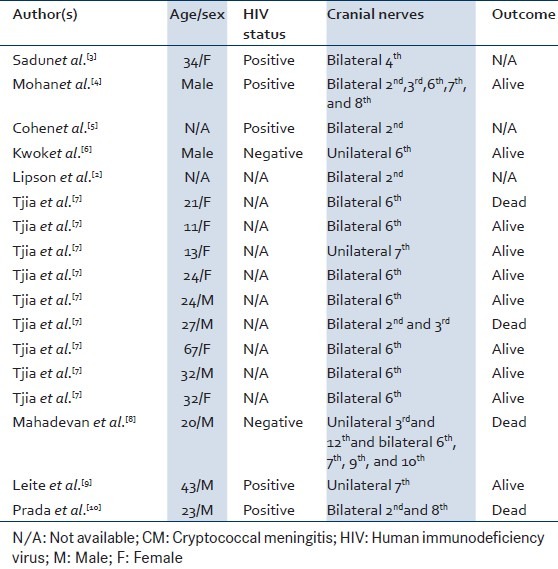Sir,
Cryptococcal meningitis (CM) is a common opportunistic infection in patients with human immunodeficiency virus (HIV) infection. If untreated, it is invariably fatal with 30–82% mortality.[1] Cranial nerve palsies are seen in about 25% of patients and usually involves a single cranial nerve, most commonly the abducens nerve. Involvement of multiple cranial nerves is very unusual. We report a 20-year-old lady who presented with multiple cranial nerve palsies due to CM as the first presentation of HIV infection. She had headache since 2 months and altered behavior since 2 days. Cranial nerves involved were the second, sixth, and seventh in the form of decreased visual acuity bilaterally, bilateral lateral rectus palsy, and left upper motor neuron facial palsy. Cerebrospinal fluid fungal culture grew colonies of Cryptococcus neoformans. Perineuritic adhesive arachnoiditis due to CM has been shown as the cause for cranial nerve palsies in autopsy studies.[2] A review of literature is shown in Table 1. [10]
Table 1.
Reported cranial nerve involvement in CM (1985–2013)

REFERENCES
- 1.Pyrgos V, Seitz AE, Steiner CA, Prevots DR, Williamson PR. Epidemiology of Cryptococcal Meningitis in the US: 1997–2009. PLoS One. 2013;8:e56269. doi: 10.1371/journal.pone.0056269. [DOI] [PMC free article] [PubMed] [Google Scholar]
- 2.Lipson BK, Freeman WR, Beniz J, Goldbaum MH, Hesselink JR, Weinreb RN, et al. Optic neuropathy associated with cryptococcal arachnoiditis in AIDS patients. Am J Ophthalmol. 1989;107:523–7. doi: 10.1016/0002-9394(89)90498-4. [DOI] [PubMed] [Google Scholar]
- 3.Sadun F, De Negri AM, Santopadre P, Pivetti Pezzi P. Bilateral trochlear nerve palsy associated with cryptococcal meningitis in human immunodeficiency virus infection. J Neuroophthalmol. 1999;19:118–9. [PubMed] [Google Scholar]
- 4.Mohan S, Ahmed SI, Alao OA, Schliep TC. A case of AIDS associated cryptococcal meningitis with multiple cranial nerve neuropathies. Clin Neurol Neurosurg. 2006;108:610–3. doi: 10.1016/j.clineuro.2006.01.005. [DOI] [PubMed] [Google Scholar]
- 5.Cohen DB, Glasgow BJ. Bilateral optic nerve cryptococcosis in sudden blindness in patients with acquired immune deficiency syndrome. Ophthalmology. 1993;100:1689–94. doi: 10.1016/s0161-6420(93)31416-8. [DOI] [PubMed] [Google Scholar]
- 6.Kwok SK, Seo SH, Ju JH, Yoon CH, Park SC, Kim BS, et al. Cryptococcal meningitis presenting with isolated sixth cranial nerve palsy in a patient with systemic lupus erythematosus. J Korean Med Sci. 2008;23:153–5. doi: 10.3346/jkms.2008.23.1.153. [DOI] [PMC free article] [PubMed] [Google Scholar]
- 7.Tjia TL, Yeow YK, Tan CB. Cryptococcal meningitis. Occasional review. J Neurol Neurosurg Psychiatry. 1985;48:853–8. doi: 10.1136/jnnp.48.9.853. [DOI] [PMC free article] [PubMed] [Google Scholar]
- 8.Mahadevan A, Kumar A, Santosh V, Satishchandra P, Shankar SK. Multiple cranial nerve involvement in cryptococcal meningitis. Ann Indian Acad Neurol. 2000;3:33–7. [Google Scholar]
- 9.Leite AG, Vidal JE, Bonasser Filho F, Nogueira RS, Oliveira AC. Cerebral infarction related to cryptococcal meningitis in an HIV-infected patient: Case report and literature review. Braz J Infect Dis. 2004;8:175–9. doi: 10.1590/s1413-86702004000200008. [DOI] [PubMed] [Google Scholar]
- 10.Prada JL, Cisneros JT, Kindelan JM, Jurado R, Villanueva JL, Navarro M, et al. Deafness and blindness in a HIV-positive patient with cryptococcal meningitis. Postgrad Med J. 1996;72:851. doi: 10.1136/pgmj.72.851.575. [DOI] [PMC free article] [PubMed] [Google Scholar]


